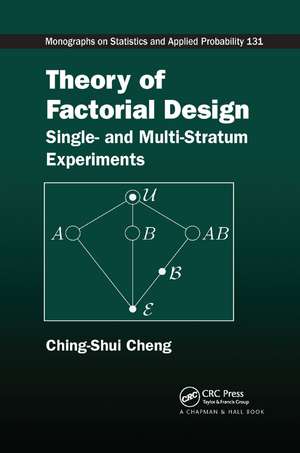Theory of Factorial Design: Single- and Multi-Stratum Experiments
Autor Ching-Shui Chengen Limba Engleză Paperback – 5 sep 2019
In addition to traditional topics and a thorough discussion of the popular minimum aberration criterion, the book covers many topics and new results not found in existing books. These include results on the structures of two-level resolution IV designs, methods for constructing such designs beyond the familiar foldover method, the extension of minimum aberration to nonregular designs, the equivalence of generalized minimum aberration and minimum moment aberration, a Bayesian approach, and some results on nonregular designs. The book also presents a theory that provides a unifying framework for the design and analysis of factorial experiments with multiple strata (error terms) arising from complicated structures of the experimental units. This theory can be systematically applied to various structures of experimental units instead of treating each on a case-by-case basis.
Preț: 493.34 lei
Preț vechi: 580.41 lei
-15% Nou
Puncte Express: 740
Preț estimativ în valută:
94.40€ • 100.95$ • 78.71£
94.40€ • 100.95$ • 78.71£
Carte tipărită la comandă
Livrare economică 18 aprilie-02 mai
Preluare comenzi: 021 569.72.76
Specificații
ISBN-13: 9780367378981
ISBN-10: 0367378981
Pagini: 409
Dimensiuni: 156 x 234 x 21 mm
Greutate: 0.57 kg
Ediția:1
Editura: CRC Press
Colecția Chapman and Hall/CRC
ISBN-10: 0367378981
Pagini: 409
Dimensiuni: 156 x 234 x 21 mm
Greutate: 0.57 kg
Ediția:1
Editura: CRC Press
Colecția Chapman and Hall/CRC
Public țintă
Professional Practice & DevelopmentCuprins
Introduction. Linear Model Basics. Randomization and Blocking. Factors. Analysis of Some Simple Orthogonal Designs. Factorial Treatment Structure and Complete Factorial Designs. Blocked, Split-Plot, and Strip-Plot Complete Factorial Designs. Fractional Factorial Designs and Orthogonal Arrays. Regular Fractional Factorial Designs. Minimum Aberration and Related Criteria. Structures and Construction of Two-Level Resolution IV Designs. Orthogonal Block Structures and Strata. Complete Factorial Designs with Orthogonal Block Structures. Multi-Stratum Fractional Factorial Designs. Non-Regular Designs. Appendix. References. Index.
Notă biografică
Ching-Shui Cheng is currently a Distinguished Research Fellow and Director of the Institute of Statistical Science, Academia Sinica, in Taiwan, and a retired professor from the University of California, Berkeley. He received his B.S. in mathematics from National Tsing Hua University and both his MS in mathematics and Ph.D. in mathematics from Cornell University. After receiving his Ph.D., he became an assistant professor in the Department of Statistics at the University of California, Berkeley. He was later promoted to associate professor and then professor. He retired on July 1, 2013.
Dr. Cheng’s research interest is mainly in experimental design and related combinatorial problems. He is a fellow of the Institute of Mathematical Statistics and the American Statistical Association and an elected member of the International Statistical Institute. He was an associate editor of the Journal of Statistical Planning and Inference, Annals of Statistics, Statistica Sinica, Biometrika, and Technometrics. He also served as the chair-editor of Statistica Sinica from 1996 to 1999.
Dr. Cheng’s research interest is mainly in experimental design and related combinatorial problems. He is a fellow of the Institute of Mathematical Statistics and the American Statistical Association and an elected member of the International Statistical Institute. He was an associate editor of the Journal of Statistical Planning and Inference, Annals of Statistics, Statistica Sinica, Biometrika, and Technometrics. He also served as the chair-editor of Statistica Sinica from 1996 to 1999.
Descriere
Bringing together both new and old results, this book provides a rigorous, systematic, and up-to-date treatment of the theoretical aspects of factorial design. To prepare readers for the general theory of multi-stratum factorial design, the author first presents a unified treatment of several simple designs. In addition to traditional topics and a thorough discussion of the popular minimum aberration criterion, the book covers many topics and results not discussed in related texts. With exercises and numerous examples, it only requires minimal prior knowledge of experimental design.
